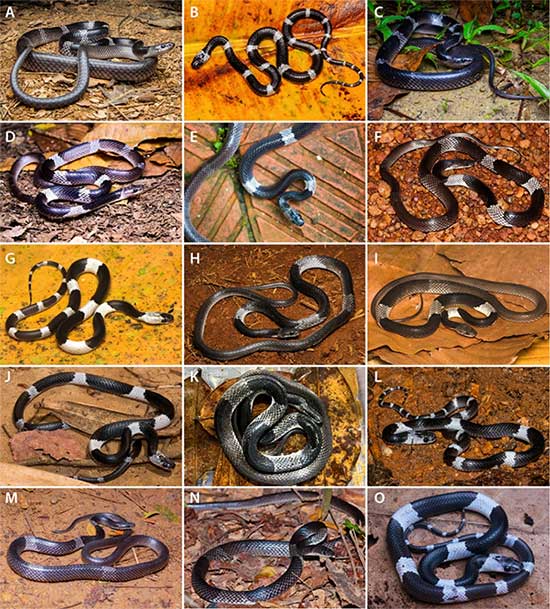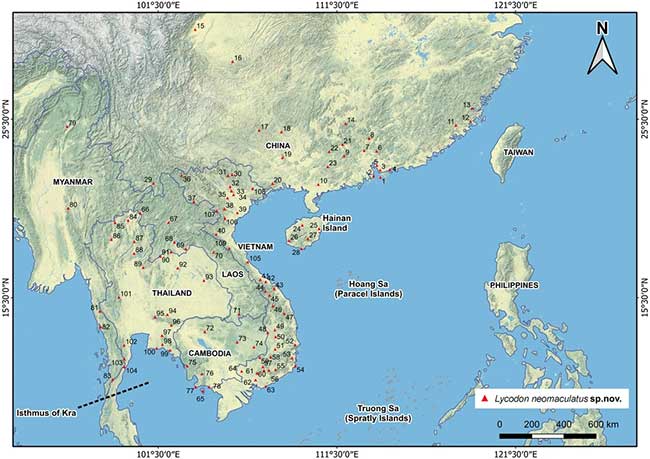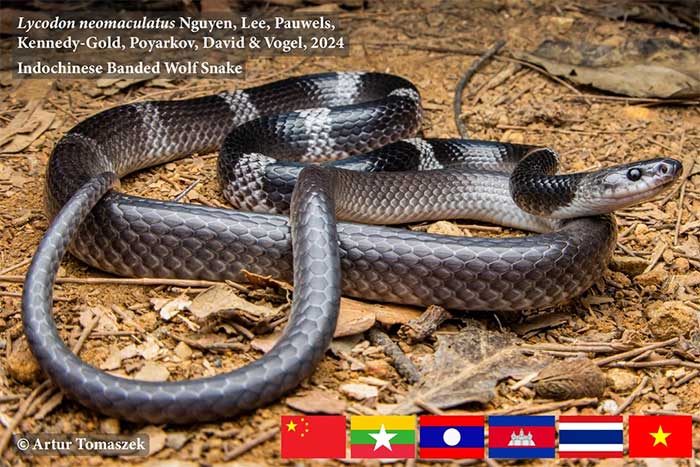A species of the genus Lycodon, distributed in Vietnam, has recently been recognized as a new snake species. This snake is harmless to humans but has an appearance similar to that of venomous snakes.
According to a scientific report published in the journal Zootaxa, scientists and biologists from various countries, including Vietnam, the United States, Belgium, Russia, France, and Germany, have conducted research on the morphological, biological, and genetic data of the Malaysian Striped Wolf Snake (scientific name Lycodon subcinctus).
Master Nguyen Van Tan, a research officer at Duy Tan University (Da Nang), who is primarily responsible for this research project, stated that the Malaysian Striped Wolf Snake has a complex classification and nomenclature history.

Morphological variations of Indochinese wolf snakes, the newly recognized species (Photo: Nguyen Van Tan).
Based on specimens collected from the Malaysian Striped Wolf Snake throughout Southeast Asia, scientists have acknowledged the presence of a new snake species named Indochinese Wolf Snake (scientific name Lycodon neomaculatus).
The Indochinese Wolf Snake exhibits distinct characteristics compared to other wolf snake species, such as the Malaysian Striped Wolf Snake or Seale’s Wolf Snake, in scale structure and skin patterns.
The Indochinese Wolf Snake is distributed in the southeastern region of China, Hainan Island, Thailand, Myanmar, Laos, Cambodia, and Vietnam. In Vietnam, this snake species is widely distributed throughout the country.

Distribution map of the Indochinese Wolf Snake (Photo: Zootaxa).
This snake primarily inhabits tropical rainforests, primary or secondary forests, shrub areas, or human-inhabited regions such as rice fields, plantations, and abandoned houses. The Indochinese Wolf Snake is typically active at night or in the early morning. During the day, it tends to hide under rocks, tree roots, pieces of wood, or in vegetation.
The Indochinese Wolf Snake is also a proficient climber, often found in large trees such as rubber or coffee. Its primary diet consists of lizards, small birds, and various amphibians like frogs and toads.
As the Indochinese Wolf Snake is a member of the Lycodon genus (also known as wolf snakes, scientific name Lycodon), it belongs to the colubrid family, making it a non-venomous snake that is harmless to humans.
However, the characteristic of species within the Lycodon genus is their bodies featuring alternating black and white bands, which often leads to confusion with the Malayan Krait, a member of the cobra family that possesses a deadly venom.


The Indochinese Wolf Snake (top) can be mistaken for the highly venomous Krait (bottom) (Photo: Nguyen Van Tan/ Parinya Herp Pawangkhanant).
As a result, wolf snakes often face “unjust deaths” because not everyone has the calmness or knowledge to identify and distinguish between the harmless Lycodon and the dangerous Krait.
| The research team studying the Indochinese Wolf Snake includes Master Nguyen Van Tan (Duy Tan University), Justin Lee (University of Michigan, USA), Olivier S. G. Pauwels (Royal Belgian Institute of Natural Sciences), Stevie R. Kennedy-Gold (Harvard University, USA), Nikolay Poyarkov (Moscow State University, Russia), Patrick David (National Museum of Natural History, France), and Gernot Vogel (independent biological researcher from Germany). |


















































